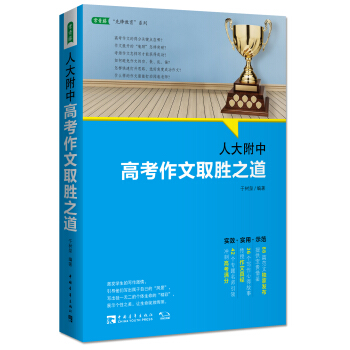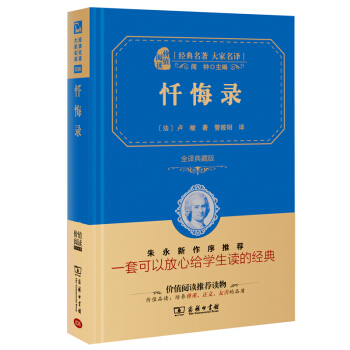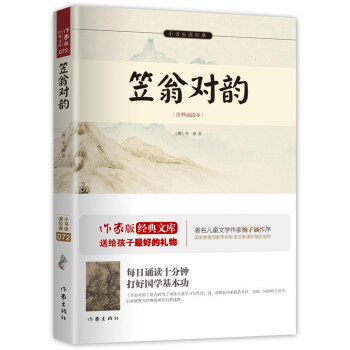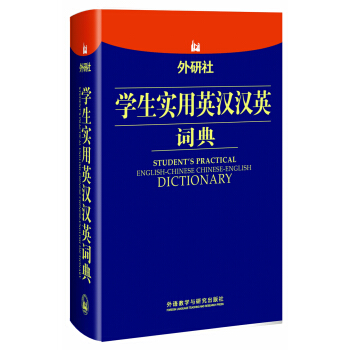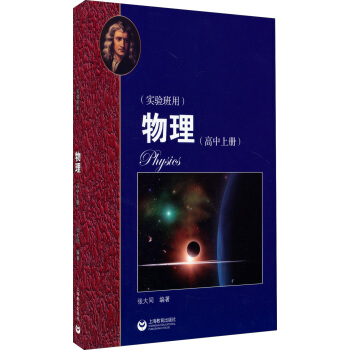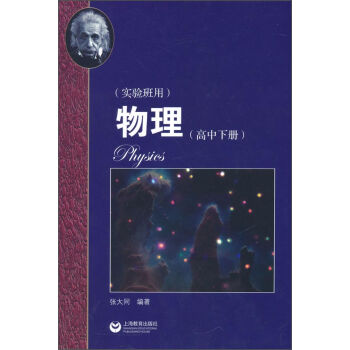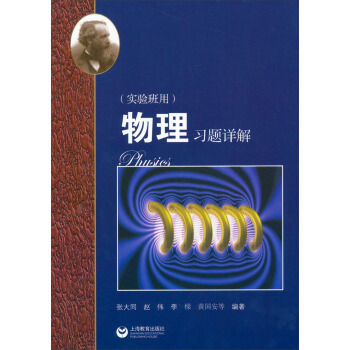具體描述
編輯推薦
zui實用的物理競賽輔導書,沒有之一;
比起中學教師寫的輔導書,概念更準確,思路更清晰;
比起大學教師寫的輔導書,更針對中學生的知識基礎,更容易理解和掌握;
與第1版相比,新增瞭50%以上的內容,插圖更清晰準確。
內容簡介
《奧林匹剋競賽實戰叢書·中學奧林匹剋競賽物理教程:電磁學篇(第2版)》是作者在長期進行奧林匹剋中學物理競賽指導和教學實踐的基礎上編寫的,傾注瞭作者對奧林匹剋物理競賽事業數十年的心血和熱情。《奧林匹剋競賽實戰叢書·中學奧林匹剋競賽物理教程:電磁學篇(第2版)》緊緊圍繞中學物理的各個方麵以及中學物理競賽內容:靜電場、穩恒電流、靜磁場、電磁感應、交流電、電磁振蕩與電磁波,在中學層麵上精闢生動地介紹瞭有關重點概念、定律和公式,結閤豐富的練習題,以生動的實例進行問題的分析和綜閤,訓練積極主動的解題思路,活躍思想,發展智能。同時,各章均給齣瞭具有一定分量的習題,並附有相應的參考答案,在科學訓練的基礎上,促使中學生整體物理素質的提高。
《奧林匹剋競賽實戰叢書·中學奧林匹剋競賽物理教程:電磁學篇(第2版)》可作為廣大中學生中學物理綜閤學習和素質提高的有效輔導書和工具書,是廣大中學生參加各類中學物理競賽、奧林匹剋物理競賽以及高考物理復習迎考的必備書籍;同時,《奧林匹剋競賽實戰叢書·中學奧林匹剋競賽物理教程:電磁學篇(第2版)》也為中學物理教師提供瞭一個物理教學探索研究的嶄新思路,是廣大中學物理教師不可多得的教學參考書。
作者簡介
程稼夫,中國物理學會委員會會員,原中國科學技術大學少年班班主任,中國科學技術大學教授,物理奧林匹剋競賽教練,國際中學生物物理奧林匹剋中國隊員教練,著有《中學奧林匹剋競賽物理講座》、《中學奧林匹剋競賽物理課程·力學篇》、《中學奧林匹剋競賽物理教程·電磁學篇》等經典學習輔導書,是目前為止zui具quanwei和實用性的參考書。
內頁插圖
目錄
第2版序
序
第1章 靜電場
1.1 電荷守恒定律
1.2 庫侖定律
1.2.1 庫侖定律包含的內容
1.2.2 電荷和質量
1.2.3 庫侖定律成立條件以及適用範圍
1.3 電場強度
1.3.1 電場強度的定義
1.3.2 電場強度疊加原理
1.3.3 若乾帶電係統産生的電場強度
1.3.4 靜電場基本定理之一——高斯定理
1.4 電勢能電勢
1.4.1 靜電勢能差靜電勢能
1.4.2 電勢差電勢
1.4.3 電勢疊加原理
1.4.4 電場綫與等勢麵
1.4.5 若乾帶電係統産生的靜電場的電勢
1.4.6 靜電場基本定理之二——環路定理
1.5 靜電場中的導體和電介質
1.5.1 靜電平衡
1.5.2 電像法
1.5.3 再論靜電屏蔽
1.5.4 靜電場的唯一性定理
1.5.5 電容和電容器
1.5.6 靜電場中的電介質
1.6 靜電能
1.6.1 點電荷係統電勢能的錶達式
1.6.2 帶電平行闆真空電容器的靜電能
1.6.3 電場能
1.6.4 利用靜電能求靜電力
1.7 例題
習題1
第2章 穩恒電流
2.1 穩恒條件
2.1.1 電流強度和電流密度
2.1.2 穩恒條件
2.2 歐姆定律和焦耳定律
2.2.1 歐姆定律電阻和電阻率
2.2.2 焦耳定律
2.2.3 金屬導電的微觀解釋
2.3 電源及電動勢
2.3.1 非靜電力
2.3.2 電動勢
2.4 電源路端電壓閉閤迴路歐姆定律
2.4.1 電源路端電壓
2.4.2 閉閤迴路歐姆定律
2.4.3 數電壓法
2.5 簡單電路
2.5.1 串聯電路
2.5.2 並聯電路
2.5.3 伏特錶和安培錶
2.5.4 歐姆錶
2.5.5 一平衡電橋
2.5.6 電位差計
2.6 復雜電路
2.6.1 基爾霍夫方程組
2.6.2 等效電源定理
2.6.3 疊加定理
2.6.4 Y-△電路的等效代換
2.7 無源電阻和電容網絡有源電阻和電容網絡
2.7.1 無源電阻網絡
2.7.2 無源電容網絡
2.7.3 有源電阻和電容網絡
2.8 物質的導電性
2.8.1 金屬的導電性
2.8.2 液體的導電性
2.8.3 氣體的導電性
2.8.4 真空中的電流
2.8.5 半導體導電
2.8.6 超導現象簡介
2.9 例題
……
第3章 靜磁場
第4章 電磁感應
第5章 交流電
第6章 電磁振蕩與電磁波
前言/序言
《中學奧林匹剋競賽物理教程:電磁學篇(第2版)》圖書簡介 本書是一部專為中國中學奧林匹剋競賽物理愛好者量身打造的深入學習教程,旨在係統地梳理和精講電磁學領域的核心知識體係,為廣大師生在競賽備戰中提供堅實理論基礎與高效解題策略。本書是“奧林匹剋競賽實戰叢書”係列中的重要一冊,秉承該係列嚴謹、實用的編撰理念,精煉奧賽曆年真題,並結閤新穎的教學方法,力求在有限的篇幅內,最大限度地提升讀者的物理思維能力與競賽競爭力。 內容概覽與特色: 本書的編排緊密圍繞中學奧林匹剋競賽物理的教學大綱和考查重點,涵蓋瞭電磁學領域最核心、最常考的幾個部分,每一章節都力求深入淺齣,既有宏觀的理論框架,又不乏微觀的細節解析。 靜電學: 本章將從電荷的性質、庫侖定律入手,詳細闡述電場強度、電勢、電勢能等基本概念。在理論講解的基礎上,本書著重強調瞭高斯定律在計算電場強度時的應用,特彆是針對各種對稱性問題的處理技巧。此外,對導體在電場中的靜電平衡、電介質的極化等進階內容也進行瞭深入剖析,並輔以大量精心設計的例題,幫助讀者熟練掌握如何分析和解決復雜的靜電場問題。電勢的計算,尤其是積分法在復雜電荷分布下的應用,是本章的難點和重點,本書將通過多角度的解析,引導讀者建立清晰的計算思路。 電容與電介質: 在深入理解瞭電場和電勢之後,本書將進一步探討電容器的工作原理。從平行闆電容器的電容公式推導,到串並聯電容器的等效計算,本書都進行瞭詳盡的介紹。特彆地,對於電容器在電路中的動態過程,如充放電,本書將結閤微分方程的方法,幫助讀者理解電荷、電流隨時間變化的規律。電介質對電容的影響,如介電常數、介電強度等概念,以及它們如何改變電場和電勢,也是本章的重點。本書還討論瞭孤立帶電體的電容以及一些特殊形狀的電容器,拓寬瞭讀者的知識視野。 恒定電流與電路: 本章是電磁學部分的基礎,也是應用最廣泛的部分。從電流的定義、歐姆定律在串聯和並聯電路中的應用,到基爾霍夫定律在復雜電路分析中的強大威力,本書都進行瞭係統而詳細的講解。電阻率、溫 Get A Handle On The Fundamentals Of Electromagnetism And Master Problem-Solving Techniques For Physics Olympiads. This Comprehensive Textbook, "Olympiad Competition Practice Series · Junior High School Olympiad Physics Tutorial: Electromagnetism (2nd Edition)," is Designed to Equip Aspiring Young Physicists with the Essential Knowledge and Advanced Strategies Needed to Excel in Physics Olympiads. Key Features and Content: The book is meticulously structured to align with the rigorous demands of Olympiad-level physics education, focusing on the core principles of electromagnetism. Each chapter offers a deep dive into fundamental concepts, progressively building towards complex problem-solving. Electrostatics: Beginning with the fundamental nature of electric charge and Coulomb's Law, this section meticulously explains electric field strength, electric potential, and potential energy. Beyond theoretical exposition, the book places significant emphasis on the application of Gauss's Law for calculating electric field strength, particularly in scenarios involving various symmetries. Furthermore, it provides in-depth analysis of crucial concepts such as electrostatic equilibrium in conductors and the polarization of dielectric materials. Numerous carefully crafted examples are included to help students develop proficiency in analyzing and resolving intricate electrostatic problems. The calculation of electric potential, especially the application of integral methods for complex charge distributions, is identified as a critical yet challenging area. This chapter guides readers through multifaceted analyses, fostering a clear computational approach. Capacitance and Dielectrics: Following a thorough understanding of electric fields and potentials, the book delves into the operational principles of capacitors. It offers a detailed exposition of the derivation of the capacitance formula for parallel-plate capacitors and the equivalent capacitance calculations for series and parallel combinations. Of particular note, the book provides a comprehensive explanation of the dynamic processes within circuits, such as charging and discharging of capacitors. It utilizes differential equations to help students grasp the laws governing the time-dependent variations of charge and current. The influence of dielectric materials on capacitance, including concepts like dielectric constant and dielectric strength, and how they modify electric fields and potentials, constitutes another key focus of this chapter. The book also examines the capacitance of isolated charged bodies and certain uniquely shaped capacitors, thereby broadening the reader's academic horizons. Steady Current and Circuits: This chapter forms the bedrock of the electromagnetism section and is characterized by its extensive practical applications. From the definition of electric current and the application of Ohm's Law in series and parallel circuits to the powerful utility of Kirchhoff's Laws in analyzing complex circuit configurations, the book provides systematic and detailed explanations. The introduction of resistivity and its temperature dependence, along with the concepts of electromotive force (EMF) and internal resistance, lays the groundwork for understanding various circuit components and their behaviors. The analysis of power consumption and energy dissipation in circuits, including the calculation of efficiency and the implications of Joule heating, is thoroughly covered. The book further explores more advanced circuit analysis techniques, such as nodal analysis and mesh analysis, equipping students with robust tools for dissecting intricate circuit networks. The examination of transient phenomena in RC and RL circuits, where the application of differential equations is essential for understanding the time-varying nature of current and voltage, is also a significant component of this chapter. The book emphasizes a systematic approach to circuit problem-solving, encouraging students to identify circuit types, apply relevant laws, and meticulously check their results. Magnetism and Magnetic Fields: This section introduces the fundamental principles of magnetism. It begins with a discussion of magnetic poles, magnetic field lines, and the concept of magnetic flux. The Ampere's Law, a cornerstone of magnetostatics, is presented in detail, along with its applications in calculating the magnetic fields generated by various current distributions, such as infinite straight wires, solenoids, and toroids. The book thoroughly explores the magnetic force exerted on moving charges (Lorentz force) and current-carrying conductors in magnetic fields, providing numerous examples to illustrate these principles. The behavior of magnetic materials, including paramagnetism, diamagnetism, and ferromagnetism, is discussed, along with their impact on magnetic fields. A significant portion of this chapter is dedicated to the analysis of electromagnetic induction, including Faraday's Law and Lenz's Law. The book explains how changing magnetic fluxes induce EMF and current, and how this phenomenon is applied in practical devices. The concept of magnetic energy stored in inductors and the dynamics of RL circuits are also covered, offering a comprehensive overview of magnetic phenomena. Electromagnetic Induction and AC Circuits: Building upon the principles of magnetism, this chapter delves into the crucial concept of electromagnetic induction. Faraday's Law and Lenz's Law are rigorously explained, with numerous examples illustrating their application in various scenarios, from simple induction coils to more complex generators. The book also explores the concept of inductance, including self-inductance and mutual inductance, and their role in RL circuits and energy storage. The transition to alternating current (AC) circuits is a significant focus. The fundamental differences between AC and DC circuits are highlighted, and the behavior of resistors, capacitors, and inductors in AC circuits is analyzed in detail, introducing concepts such as impedance, reactance, and phase. The book covers resonance phenomena in RLC circuits, a topic of paramount importance in many physics and engineering applications. The calculation of RMS values for voltage and current, and the concept of power in AC circuits, are also thoroughly explained. Electromagnetic Waves: The final chapter provides an introduction to electromagnetic waves, unifying electricity and magnetism. Based on Maxwell's equations (presented conceptually without requiring advanced calculus for introductory purposes), the book explains the nature of electromagnetic waves as propagating disturbances in electric and magnetic fields. The spectrum of electromagnetic waves, from radio waves to gamma rays, is discussed, along with their properties and applications. The concept of the speed of light as a fundamental constant arising from electromagnetic theory is emphasized. While not delving into the rigorous mathematical derivation of Maxwell's equations, this chapter aims to provide a conceptual understanding of how oscillating charges generate electromagnetic waves and how these waves carry energy and momentum. Pedagogical Approach: Conceptual Clarity: Each topic is introduced with clear definitions and intuitive explanations, building a strong conceptual foundation. The book avoids jargon where possible and clarifies complex terms when introduced. Rigorous Mathematical Treatment: While emphasizing conceptual understanding, the book also provides the necessary mathematical framework for solving Olympiad-level problems. Derivations are presented step-by-step, making them accessible to students. Abundant Solved Examples: A wide range of solved examples are integrated throughout the text, covering various difficulty levels and problem types. These examples serve not only to illustrate theoretical concepts but also to demonstrate effective problem-solving strategies. Olympiad-Specific Problem-Solving Techniques: The book focuses on techniques and approaches that are particularly useful for Olympiad competitions. This includes strategies for simplifying complex problems, identifying symmetries, and using conservation laws effectively. Chapter-End Exercises: Each chapter concludes with a set of carefully selected exercises, ranging from straightforward drills to challenging problems that require deeper insight and synthesis of knowledge. Answers and hints are provided for most exercises to facilitate self-study. Concise and Targeted Content: The content is carefully curated to focus on topics frequently appearing in Olympiad physics examinations, ensuring that students' study efforts are directed towards the most relevant material. Clear and Engaging Language: The prose is clear, direct, and engaging, making the learning process enjoyable and effective. The book avoids overly academic or dry language. Target Audience: This book is an indispensable resource for: Junior High School Students: Preparing for physics Olympiad competitions at the national and international levels. Physics Enthusiasts: Seeking a deeper and more rigorous understanding of electromagnetism beyond the standard curriculum. Physics Teachers and Tutors: Looking for supplementary materials and advanced teaching aids to guide their students in Olympiad preparation. By mastering the content presented in "Olympiad Competition Practice Series · Junior High School Olympiad Physics Tutorial: Electromagnetism (2nd Edition)," students will not only be well-equipped to tackle the challenges of physics Olympiads but will also develop a profound and lasting appreciation for the elegance and power of electromagnetism. This book is a testament to the belief that with dedication, clear guidance, and rigorous practice, students can achieve remarkable success in the exciting field of physics.






